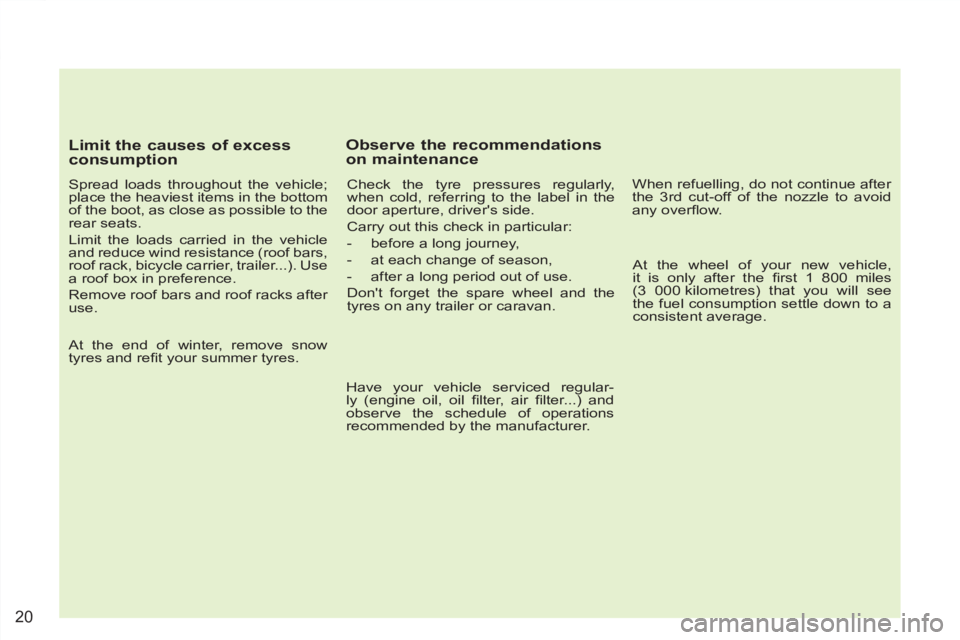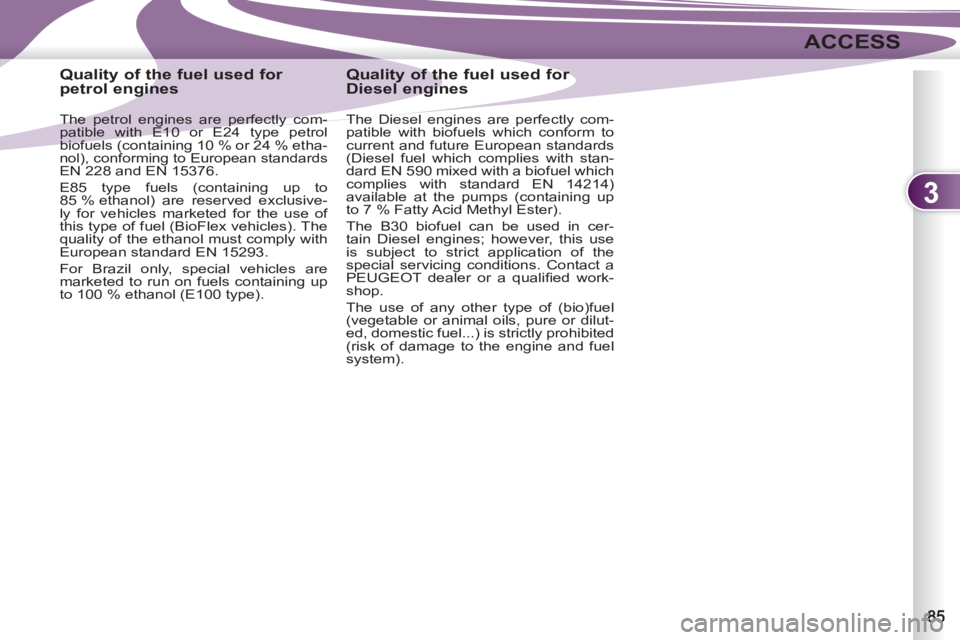2012 PEUGEOT 4007 engine oil
[x] Cancel search: engine oilPage 22 of 236

20
Limit the causes of excess
consumption
Spread loads throughout the vehicle;
place the heaviest items in the bottom
of the boot, as close as possible to the
rear seats.
Limit the loads carried in the vehicle
and reduce wind resistance (roof bars,
roof rack, bicycle carrier, trailer...). Use
a roof box in preference.
Remove roof bars and roof racks after
use.
At the end of winter, remove snow
tyres and refi t your summer tyres.
Observe the recommendations
on maintenance
Check the tyre pressures regularly,
when cold, referring to the label in the
door aperture, driver's side.
Carry out this check in particular:
- before a long journey,
- at each change of season,
- after a long period out of use.
Don't forget the spare wheel and the
tyres on any trailer or caravan.
Have your vehicle serviced regular-
ly (engine oil, oil fi lter, air fi lter...) and
observe the schedule of operations
recommended by the manufacturer.
When refuelling, do not continue after
the 3 rd cut-off of the nozzle to avoid
any overfl ow.
At the wheel of your new vehicle,
it is only after the fi rst 1 800 miles
(3 000 kilometres) that you will see
the fuel consumption settle down to a
consistent average.
Page 29 of 236

1
!
INSTRUMENTS and CONTROLS
Message
is on
Cause
Solution - action
Observations
Airbags
Fixed Fault in the airbags or
pretensioners. Contact a PEUGEOT
dealer or a qualifi ed
workshop.
Service
Fixed Problem in one of the
systems which does
not have a specifi c
message. Stop the vehicle and
contact a PEUGEOT
dealer or a qualifi ed
workshop. To identify the problem,
contact a PEUGEOT
dealer or a qualifi ed
workshop.
Engine oil
pressure
Fixed Engine oil pressure too
low or fault in the engine
lubrication system. Stop the vehicle and
contact a PEUGEOT
dealer or a qualifi ed
workshop.
Engine oil
level
Fixed Engine oil level too low. Stop the vehicle and
check the level using the
dipstick. If there is a lack of oil,
top up the level.
Low fuel
warning
Fixed The fuel level is low. Refuel as soon as
possible.
Fuel system
Fixed Fuel system fault. Contact a PEUGEOT
dealer or a qualifi ed
workshop.
Opening
not closed
correctly
Fixed One of the doors or the
tailgate is not closed
correctly. Close the door or the
tailgate. The opening concerned
is indicated on the
screen.
Page 87 of 236

3
ACCESS
Quality of the fuel used for
petrol engines
The petrol engines are perfectly com-
patible with E10 or E24 type petrol
biofuels (containing 10 % or 24 % etha-
nol), conforming to European standards EN 228 and EN 15376.
E85 type fuels (containing up to
85 % ethanol) are reserved exclusive-
ly for vehicles marketed for the use of
this type of fuel (BioFlex vehicles). The
quality of the ethanol must comply with
European standard EN 15293.
For Brazil only, special vehicles are
marketed to run on fuels containing up
to 100 % ethanol (E100 type).
Quality of the fuel used for
Diesel engines
The Diesel engines are perfectly com-
patible with biofuels which conform to
current and future European standards
(Diesel fuel which complies with stan-
dard EN 590 mixed with a biofuel which
complies with standard EN 14214)
available at the pumps (containing up
to 7 % Fatty Acid Methyl Ester).
The B30 biofuel can be used in cer-
tain Diesel engines; however, this use
is subject to strict application of the
special servicing conditions. Contact a
PEUGEOT dealer or a qualifi ed work-
shop.
The use of any other type of (bio)fuel
(vegetable or animal oils, pure or dilut-
ed, domestic fuel...) is strictly prohibited
(risk of damage to the engine and fuel
system).
Page 129 of 236

8
CHECKS
PETROL ENGINE
1.
Screenwash and headlamp wash
reservoir.
2.
Coolant reservoir.
3.
Power steering fl uid reservoir.
4.
Brake fl uid reservoir.
5.
Fusebox.
6.
Battery.
7.
CVT gearbox dipstick.
8.
Radiator cap.
9.
Engine oil dipstick.
10.
Engine oil fi ller cap.
11 .
Air fi lter. Access for checking the levels of the various fl uids and the replacement of certain components.
Page 130 of 236

8
CHECKS
SEL ENGINEDIESEL EN
Access for checking the levels of the various fl uids and the replacement of certain components.
1.
Coolant reservoir.
2.
Power steering fl uid reservoir.
3.
Screenwash and headlamp wash
reservoir.
4.
Brake fl uid reservoir.
5.
Fusebox.
6.
Battery.
7.
Engine oil dipstick.
8.
Engine oil fi ller cap.
9.
Air fi lter.
Page 131 of 236

8
CHECKS
CHECKING LEVELS
Brake fluid level
To avoid any risk of scalding, unscrew
the cap by two turns to allow the pres-
sure to drop. When the pressure has
dropped, remove the cap and top up
the level.
Oil level
The reading will only be correct
if the vehicle is on level ground
and the engine has been off for
more than 15 minutes.
The check is carried out either
when the ignition is switched on using
the oil level indicator on the instrument
panel, or using the dipstick.
It is normal to top up the engine oil be-
tween services. The manufacturer recom-
mends that the oil level be checked, and
topped up if necessary, every 3 000 miles
(5 000 km). The brake fl uid level should be
between the "MAX" and "MIN"
marks.
If it is not, check the brake pad
wear.
Changing the brake fl uid
Refer to the servicing booklet for details
of the interval for this operation.
Coolant level
The coolant level must be mea-
sured when the engine is cold
and should be between the
"LOW" and "FULL" marks.
When the engine is warm, the
temperature of the coolant is regulated
by the fan. This can operate with the ig-
nition off.
On vehicles which are fi tted with a
particle emission fi lter, the fan may
operate after the vehicle has been
switched off, even if the engine is
cold.
In addition, as the cooling system is
pressurised, wait at least one hour after
switching off the engine before carrying
out any work.
Screenwash and headlamp
wash * fluid
Check the fl uid level regularly,
using the gauge.
*
According to country.
Changing the engine oil
Refer to the servicing booklet for details
of the interval for this operation.
In order to maintain the reliability of the
engine and emission control system,
the use of additives in the engine oil is
prohibited.
Oil specifi cation
The oil must correspond to your engine
and conform to the manufacturer's
recommendations.
Fluid specifi cation
The brake fl uid must conform to the
manufacturer's recommendations and
fulfi l the DOT4 standards.
Changing the coolant fl uid
Refer to the servicing booklet for details
of the interval for this operation.
Fluid specifi cation
The coolant must conform to the manu-
facturer's recommendations.
Fluid specifi cation
This fl uid must conform to the manufac-
turer's recommendations for optimum
cleaning.
Power steering fluid level
Check the fl uid level with the engine at
idle.
Check that the power steering fl uid
level is always between the "MAX" and
"MIN" marks and top up if necessary.
Fluid specifi cation
This fl uid must conform to the manufac-
turer's recommendations.
Check all of these levels regularly and
top them up if necessary, unless other-
wise indicated.
If a level drops signifi cantly, have the
corresponding system checked by a
PEUGEOT dealer or a qualifi ed work-
shop.
When working under the bonnet, take
care as certain areas of the engine may
be extremely hot (risk of burns).
Page 132 of 236

8
CHECKS
Diesel additive level (Diesel
with particle emission filter)
The minimum level of this additive is indicat-
ed by lighting of the service warning lamp,
accompanied by an audible signal and a
message on the multifunction screen.
Topping up
This additive must be topped up by a
PEUGEOT dealer or a qualifi ed work-
shop without delay.
Waste products
CHECKS
Battery
Check the electrolyte level
regularly. If necessary, top up
the level with distilled water.
Check that the terminals are
clean and correctly tightened,
particularly in summer and winter.
When carrying out work on the battery,
refer to the "Practical information" sec-
tion for details of the precautions to be
taken before disconnecting the battery
and following its reconnection.
Air filter and passenger compartment filter
Refer to the servicing booklet
for details of the replacement
intervals for these compo-
nents.
Depending on the environ-
ment (dusty atmosphere...) and the use
of the vehicle (city driving...), replace
them twice as often if necessary (refer
to the "Engines" paragraph).
A clogged passenger compartment fi l-
ter may have an adverse effect on the
performance of the air conditioning sys-
tem and generate undesirable odours.
Oil filter
Replace the oil fi lter each time
the engine oil is changed.
Refer to the servicing booklet
for details of the replacement
interval for this component.
Particle emission filter (Diesel)
Maintenance of the particle emission fi l-
ter must be carried out by a PEUGEOT
dealer or a qualifi ed workshop.
Following prolonged operation
of the vehicle at very low speed
or at idle, you may, exception-
ally, notice the emission of water
vapour at the exhaust on accel-
eration. This does not have any
adverse effect on the perfor-
mance of the vehicle or on the
environment.
Avoid any prolonged contact of
used oil or fl uids with the skin.
Most of these fl uids are harmful
to health or indeed very corro-
sive.
Do not discard used oil or fl uids into
sewers or onto the ground.
Empty used oil into the containers pro-
vided for this purpose at PEUGEOT
dealers (France) or a qualifi ed work-
shop, or take them to an authorised
waste disposal site.
Do not discard the oil fi lter through
public channels, deposit it in the
containers dedicated to this use in
the PEUGEOT network (France) or
a qualifi ed workshop or take them to
an authorised waste disposal site.
Unless otherwise indicated, check
these components in accordance with
the servicing booklet and in relation to
your engine.
Otherwise, have them checked by a
PEUGEOT dealer or a qualifi ed work-
shop.
Page 149 of 236

9
PRACTICAL INFORMATION
Engine compartment fuses
The fusebox is placed in the engine compartment near the
battery (left-hand side).
Access to the fuses
�)
Open the bonnet (refer to the "Access" section),
�)
Press on the hook A
to release the catch,
�)
Remove the cover completely,
�)
Change the fuse (refer to the corresponding paragraph),
�)
When you have fi nished, close the cover carefully to en-
sure sealing of the fusebox.
Fuse N°
Rating
Functions
1
15 A
Front foglamps.
2
7 A
Engine ECU 2.4 litre 16 V
3
20 A
CVT automatic gearbox ECU, CVT
automatic gearbox relay
4
10 A
Horn.
5
7.5 A
Alternator 2.4 litre 16V
6
20 A
Headlamp wash.
7
10 A
Air conditioning.
8
15 A
Engine ECU 2.4 litre 16 V
9
-
Not used.
10
15 A
Demisting, wipers.
11
-
Not used.
12
-
Not used.
13
-
Not used.
14
10 A
Left-hand main beam headlamp.
15
10 A
Right-hand main beam headlamp.
16
20 A
Left-hand dipped beam headlamp (xenon).
17
20 A
Right-hand dipped beam headlamp (xenon).
18
10 A
Left-hand dipped beam headlamp, manual
and automatic headlamp adjustment.
19
10 A
Right-hand dipped beam headlamp.
20
-
Not used.
21
10 A
Ignition coils